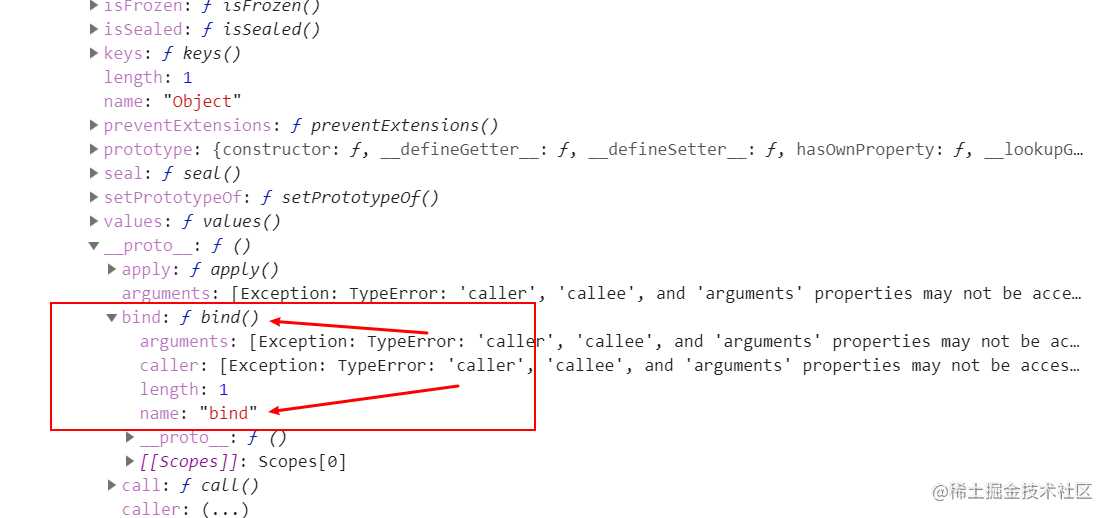前言
你好,我是若川。这是面试官问系列的第二篇,旨在帮助读者提升
JS基础知识,包含new、call、apply、this、继承相关知识。
面试官问系列文章如下:感兴趣的读者可以点击阅读。
1.面试官问:能否模拟实现JS的new操作符
2.面试官问:能否模拟实现JS的bind方法
3.面试官问:能否模拟实现JS的call和apply方法
4.面试官问:JS的this指向
5.面试官问:JS的继承
用过React的同学都知道,经常会使用bind来绑定this。
import React, { Component } from 'react';
class TodoItem extends Component{
constructor(props){
super(props);
this.handleClick = this.handleClick.bind(this);
}
handleClick(){
console.log('handleClick');
}
render(){
return (
<div onClick={this.handleClick}>点击</div>
);
};
}
export default TodoItem;
那么面试官可能会问是否想过bind到底做了什么,怎么模拟实现呢。
附上之前写文章写过的一段话:已经有很多模拟实现
bind的文章,为什么自己还要写一遍呢。学习就好比是座大山,人们沿着不同的路登山,分享着自己看到的风景。你不一定能看到别人看到的风景,体会到别人的心情。只有自己去登山,才能看到不一样的风景,体会才更加深刻。
先看一下bind是什么。从上面的React代码中,可以看出bind执行后是函数,并且每个函数都可以执行调用它。 眼见为实,耳听为虚。读者可以在控制台一步步点开例子1中的obj:
var obj = {};
console.log(obj);
console.log(typeof Function.prototype.bind); // function
console.log(typeof Function.prototype.bind()); // function
console.log(Function.prototype.bind.name); // bind
console.log(Function.prototype.bind().name); // bound

因此可以得出结论1:
1、bind是Functoin原型链中Function.prototype的一个属性,每个函数都可以调用它。
2、bind本身是一个函数名为bind的函数,返回值也是函数,函数名是bound。(打出来就是bound加上一个空格)。 知道了bind是函数,就可以传参,而且返回值'bound '也是函数,也可以传参,就很容易写出例子2:
后文统一 bound 指原函数original bind之后返回的函数,便于说明。
var obj = {
name: '若川',
};
function original(a, b){
console.log(this.name);
console.log([a, b]);
return false;
}
var bound = original.bind(obj, 1);
var boundResult = bound(2); // '若川', [1, 2]
console.log(boundResult); // false
console.log(original.bind.name); // 'bind'
console.log(original.bind.length); // 1
console.log(original.bind().length); // 2 返回original函数的形参个数
console.log(bound.name); // 'bound original'
console.log((function(){}).bind().name); // 'bound '
console.log((function(){}).bind().length); // 0
由此可以得出结论2:
1、调用bind的函数中的this指向bind()函数的第一个参数。
2、传给bind()的其他参数接收处理了,bind()之后返回的函数的参数也接收处理了,也就是说合并处理了。
3、并且bind()后的name为bound + 空格 + 调用bind的函数名。如果是匿名函数则是bound + 空格。
4、bind后的返回值函数,执行后返回值是原函数(original)的返回值。
5、bind函数形参(即函数的length)是1。bind后返回的bound函数形参不定,根据绑定的函数原函数(original)形参个数确定。
根据结论2:我们就可以简单模拟实现一个简版bindFn
// 第一版 修改this指向,合并参数
Function.prototype.bindFn = function bind(thisArg){
if(typeof this !== 'function'){
throw new TypeError(this + 'must be a function');
}
// 存储函数本身
var self = this;
// 去除thisArg的其他参数 转成数组
var args = [].slice.call(arguments, 1);
var bound = function(){
// bind返回的函数 的参数转成数组
var boundArgs = [].slice.call(arguments);
// apply修改this指向,把两个函数的参数合并传给self函数,并执行self函数,返回执行结果
return self.apply(thisArg, args.concat(boundArgs));
}
return bound;
}
// 测试
var obj = {
name: '若川',
};
function original(a, b){
console.log(this.name);
console.log([a, b]);
}
var bound = original.bindFn(obj, 1);
bound(2); // '若川', [1, 2]
如果面试官看到你答到这里,估计对你的印象60、70分应该是会有的。 但我们知道函数是可以用new来实例化的。那么bind()返回值函数会是什么表现呢。
接下来看例子3:
var obj = {
name: '若川',
};
function original(a, b){
console.log('this', this); // original {}
console.log('typeof this', typeof this); // object
this.name = b;
console.log('name', this.name); // 2
console.log('this', this); // original {name: 2}
console.log([a, b]); // 1, 2
}
var bound = original.bind(obj, 1);
var newBoundResult = new bound(2);
console.log(newBoundResult, 'newBoundResult'); // original {name: 2}
从例子3种可以看出this指向了new bound()生成的新对象。
可以分析得出结论3:
1、bind原先指向obj的失效了,其他参数有效。
2、new bound的返回值是以original原函数构造器生成的新对象。original原函数的this指向的就是这个新对象。 另外前不久写过一篇文章:面试官问:能否模拟实现JS的new操作符。简单摘要: new做了什么:
1.创建了一个全新的对象。
2.这个对象会被执行[[Prototype]](也就是__proto__)链接。
3.生成的新对象会绑定到函数调用的this。
4.通过new创建的每个对象将最终被[[Prototype]]链接到这个函数的prototype对象上。
5.如果函数没有返回对象类型Object(包含Functoin,Array,Date,RegExg,Error),那么new表达式中的函数调用会自动返回这个新的对象。
所以相当于new调用时,bind的返回值函数bound内部要模拟实现new实现的操作。 话不多说,直接上代码。
// 第三版 实现new调用
Function.prototype.bindFn = function bind(thisArg){
if(typeof this !== 'function'){
throw new TypeError(this + ' must be a function');
}
// 存储调用bind的函数本身
var self = this;
// 去除thisArg的其他参数 转成数组
var args = [].slice.call(arguments, 1);
var bound = function(){
// bind返回的函数 的参数转成数组
var boundArgs = [].slice.call(arguments);
var finalArgs = args.concat(boundArgs);
// new 调用时,其实this instanceof bound判断也不是很准确。es6 new.target就是解决这一问题的。
if(this instanceof bound){
// 这里是实现上文描述的 new 的第 1, 2, 4 步
// 1.创建一个全新的对象
// 2.并且执行[[Prototype]]链接
// 4.通过`new`创建的每个对象将最终被`[[Prototype]]`链接到这个函数的`prototype`对象上。
// self可能是ES6的箭头函数,没有prototype,所以就没必要再指向做prototype操作。
if(self.prototype){
// ES5 提供的方案 Object.create()
// bound.prototype = Object.create(self.prototype);
// 但 既然是模拟ES5的bind,那浏览器也基本没有实现Object.create()
// 所以采用 MDN ployfill方案 https://developer.mozilla.org/zh-CN/docs/Web/JavaScript/Reference/Global_Objects/Object/create
function Empty(){}
Empty.prototype = self.prototype;
bound.prototype = new Empty();
}
// 这里是实现上文描述的 new 的第 3 步
// 3.生成的新对象会绑定到函数调用的`this`。
var result = self.apply(this, finalArgs);
// 这里是实现上文描述的 new 的第 5 步
// 5.如果函数没有返回对象类型`Object`(包含`Functoin`, `Array`, `Date`, `RegExg`, `Error`),
// 那么`new`表达式中的函数调用会自动返回这个新的对象。
var isObject = typeof result === 'object' && result !== null;
var isFunction = typeof result === 'function';
if(isObject || isFunction){
return result;
}
return this;
}
else{
// apply修改this指向,把两个函数的参数合并传给self函数,并执行self函数,返回执行结果
return self.apply(thisArg, finalArgs);
}
};
return bound;
}
面试官看到这样的实现代码,基本就是满分了,心里独白:这小伙子/小姑娘不错啊。不过可能还会问this instanceof bound不准确问题。 上文注释中提到this instanceof bound也不是很准确,ES6 new.target很好的解决这一问题,我们举个例子4:
instanceof 不准确,ES6 new.target很好的解决这一问题
function Student(name){
if(this instanceof Student){
this.name = name;
console.log('name', name);
}
else{
throw new Error('必须通过new关键字来调用Student。');
}
}
var student = new Student('若');
var notAStudent = Student.call(student, '川'); // 不抛出错误,且执行了。
console.log(student, 'student', notAStudent, 'notAStudent');
function Student2(name){
if(typeof new.target !== 'undefined'){
this.name = name;
console.log('name', name);
}
else{
throw new Error('必须通过new关键字来调用Student2。');
}
}
var student2 = new Student2('若');
var notAStudent2 = Student2.call(student2, '川');
console.log(student2, 'student2', notAStudent2, 'notAStudent2'); // 抛出错误
细心的同学可能会发现了这版本的代码没有实现bind后的bound函数的nameMDN Function.name和lengthMDN Function.length。面试官可能也发现了这一点继续追问,如何实现,或者问是否看过es5-shim的源码实现L201-L335。如果不限ES版本。其实可以用ES5的Object.defineProperties来实现。
Object.defineProperties(bound, {
'length': {
value: self.length,
},
'name': {
value: 'bound ' + self.name,
}
});
es5-shim的源码实现bind
直接附上源码(有删减注释和部分修改等)
var $Array = Array;
var ArrayPrototype = $Array.prototype;
var $Object = Object;
var array_push = ArrayPrototype.push;
var array_slice = ArrayPrototype.slice;
var array_join = ArrayPrototype.join;
var array_concat = ArrayPrototype.concat;
var $Function = Function;
var FunctionPrototype = $Function.prototype;
var apply = FunctionPrototype.apply;
var max = Math.max;
// 简版 源码更复杂些。
var isCallable = function isCallable(value){
if(typeof value !== 'function'){
return false;
}
return true;
};
var Empty = function Empty() {};
// 源码是 defineProperties
// 源码是bind笔者改成bindFn便于测试
FunctionPrototype.bindFn = function bind(that) {
var target = this;
if (!isCallable(target)) {
throw new TypeError('Function.prototype.bind called on incompatible ' + target);
}
var args = array_slice.call(arguments, 1);
var bound;
var binder = function () {
if (this instanceof bound) {
var result = apply.call(
target,
this,
array_concat.call(args, array_slice.call(arguments))
);
if ($Object(result) === result) {
return result;
}
return this;
} else {
return apply.call(
target,
that,
array_concat.call(args, array_slice.call(arguments))
);
}
};
var boundLength = max(0, target.length - args.length);
var boundArgs = [];
for (var i = 0; i < boundLength; i++) {
array_push.call(boundArgs, '$' + i);
}
// 这里是Function构造方式生成形参length $1, $2, $3...
bound = $Function('binder', 'return function (' + array_join.call(boundArgs, ',') + '){ return binder.apply(this, arguments); }')(binder);
if (target.prototype) {
Empty.prototype = target.prototype;
bound.prototype = new Empty();
Empty.prototype = null;
}
return bound;
};
你说出es5-shim源码bind实现,感慨这代码真是高效、严谨。面试官心里独白可能是:你就是我要找的人,薪酬福利你可以和HR去谈下。
最后总结一下
1、bind是Function原型链中的Function.prototype的一个属性,它是一个函数,修改this指向,合并参数传递给原函数,返回值是一个新的函数。
2、bind返回的函数可以通过new调用,这时提供的this的参数被忽略,指向了new生成的全新对象。内部模拟实现了new操作符。
3、es5-shim源码模拟实现bind时用Function实现了length。
事实上,平时其实很少需要使用自己实现的投入到生成环境中。但面试官通过这个面试题能考察很多知识。比如this指向,原型链,闭包,函数等知识,可以扩展很多。
读者发现有不妥或可改善之处,欢迎指出。另外觉得写得不错,可以点个赞,也是对笔者的一种支持。
文章中的例子和测试代码放在github中bind模拟实现 github。bind模拟实现 预览地址 F12看控制台输出,结合source面板查看效果更佳。
// 最终版 删除注释 详细注释版请看上文
Function.prototype.bind = Function.prototype.bind || function bind(thisArg){
if(typeof this !== 'function'){
throw new TypeError(this + ' must be a function');
}
var self = this;
var args = [].slice.call(arguments, 1);
var bound = function(){
var boundArgs = [].slice.call(arguments);
var finalArgs = args.concat(boundArgs);
if(this instanceof bound){
if(self.prototype){
function Empty(){}
Empty.prototype = self.prototype;
bound.prototype = new Empty();
}
var result = self.apply(this, finalArgs);
var isObject = typeof result === 'object' && result !== null;
var isFunction = typeof result === 'function';
if(isObject || isFunction){
return result;
}
return this;
}
else{
return self.apply(thisArg, finalArgs);
}
};
return bound;
}
参考
OshotOkill翻译的 深入理解ES6 简体中文版 – 第三章 函数(虽然笔者是看的纸质书籍,但推荐下这本在线的书)
MDN Function.prototype.bind
冴羽: JavaScript深入之bind的模拟实现
《react状态管理与同构实战》侯策:从一道面试题,到“我可能看了假源码”
笔者精选文章
学习 sentry 源码整体架构,打造属于自己的前端异常监控SDK
学习 lodash 源码整体架构,打造属于自己的函数式编程类库
学习 underscore 源码整体架构,打造属于自己的函数式编程类库
学习 jQuery 源码整体架构,打造属于自己的 js 类库
面试官问:JS的继承
面试官问:JS的this指向
面试官问:能否模拟实现JS的call和apply方法
面试官问:能否模拟实现JS的bind方法
面试官问:能否模拟实现JS的new操作符
前端使用puppeteer 爬虫生成《React.js 小书》PDF并合并
关于
作者:常以若川为名混迹于江湖。前端路上 | PPT爱好者 | 所知甚少,唯善学。
个人博客
segmentfault前端视野专栏,开通了前端视野专栏,欢迎关注~
掘金专栏,欢迎关注~
知乎前端视野专栏,开通了前端视野专栏,欢迎关注~
github blog,求个star^_^~
微信公众号 若川视野
可能比较有趣的微信公众号,长按扫码关注。也可以加微信 ruochuan12,注明来源,拉您进【前端视野交流群】。

今天的文章面试官问:能否模拟实现JS的bind方法分享到此就结束了,感谢您的阅读。
版权声明:本文内容由互联网用户自发贡献,该文观点仅代表作者本人。本站仅提供信息存储空间服务,不拥有所有权,不承担相关法律责任。如发现本站有涉嫌侵权/违法违规的内容, 请发送邮件至 举报,一经查实,本站将立刻删除。
如需转载请保留出处:https://bianchenghao.cn/18020.html
